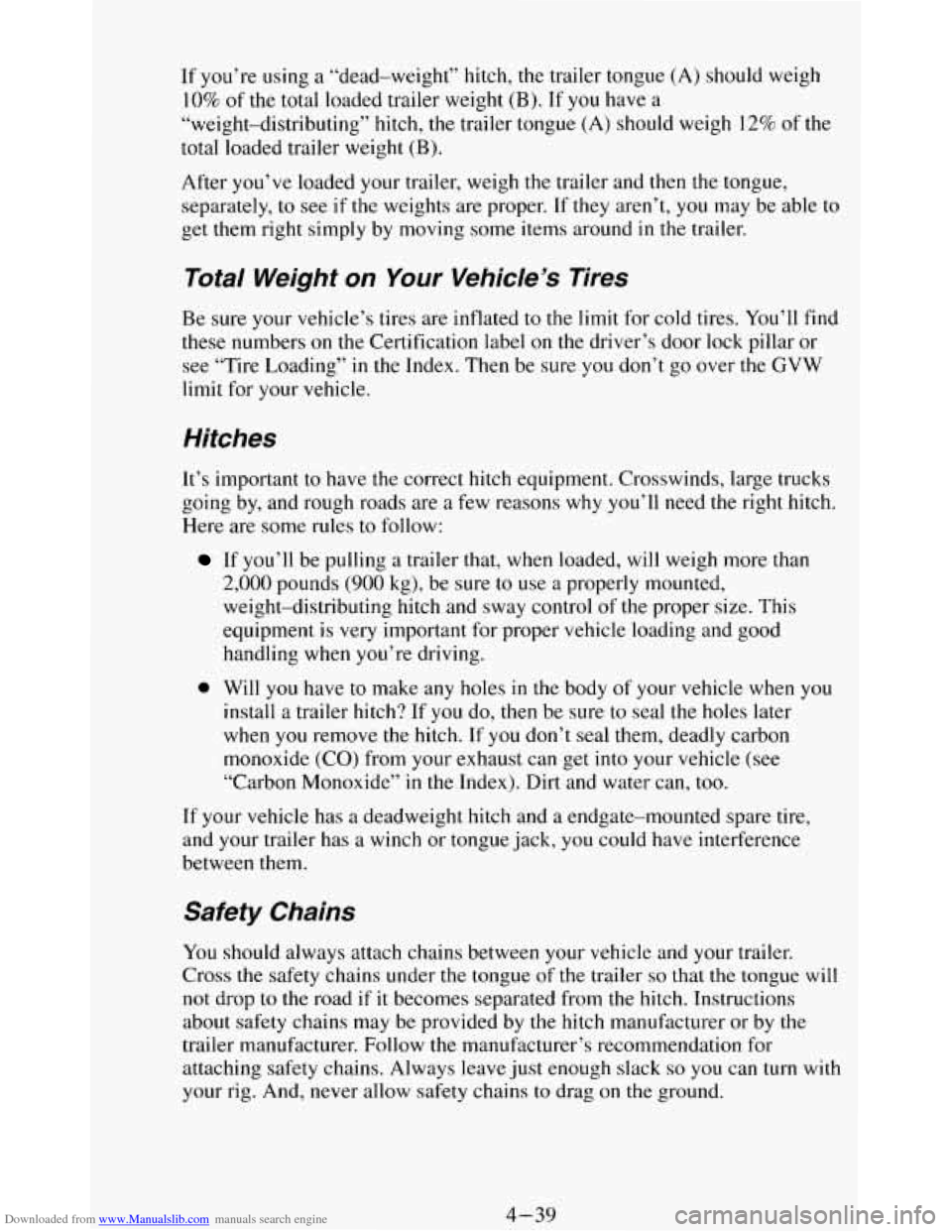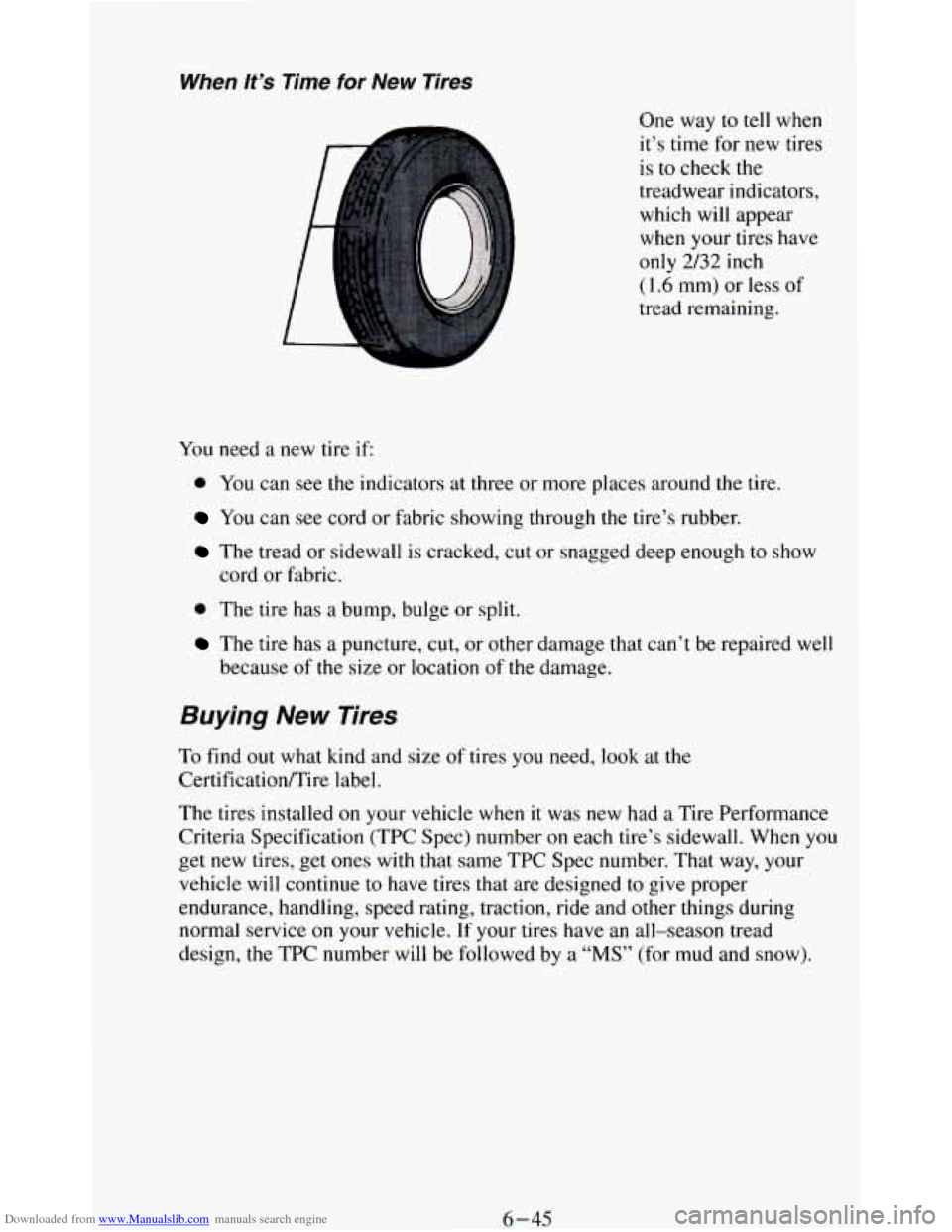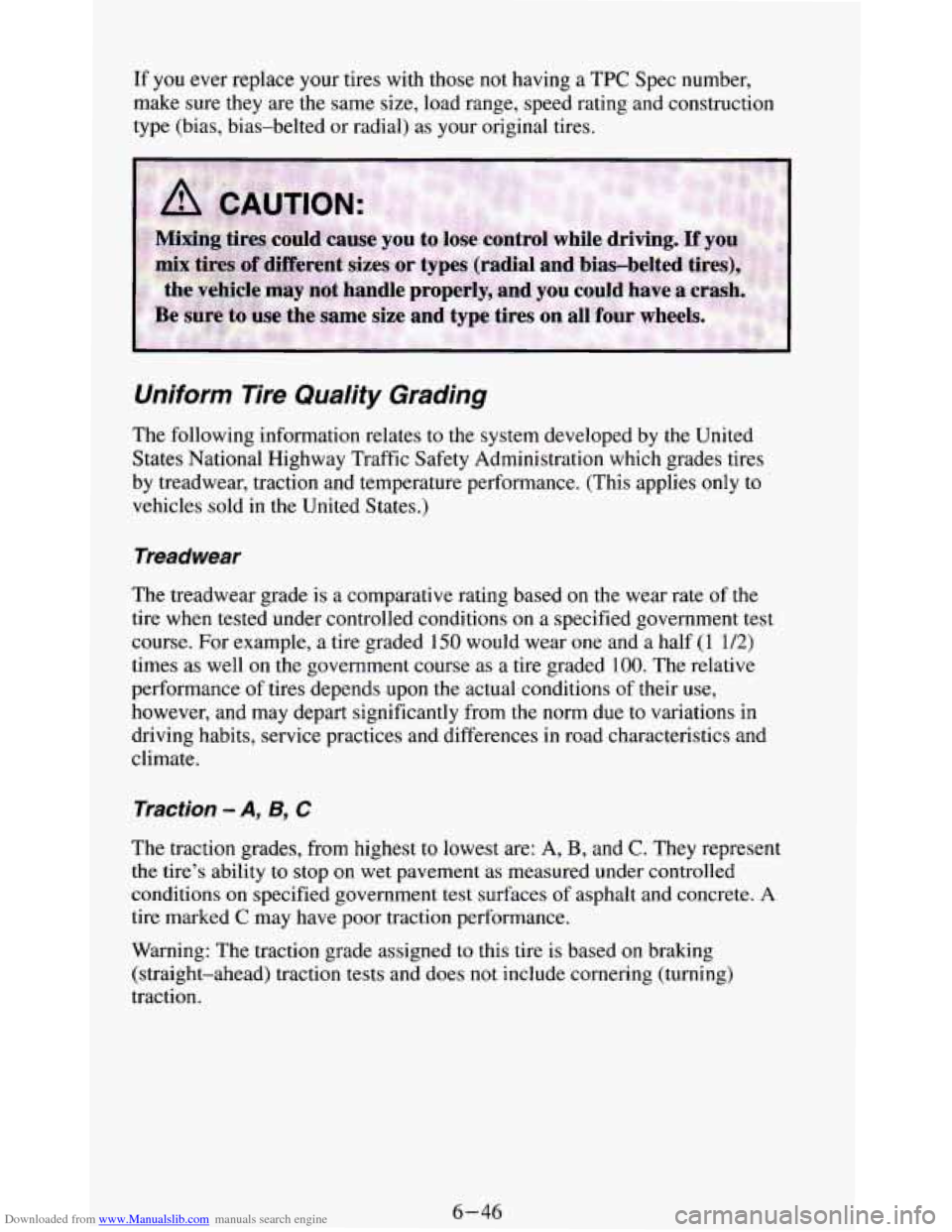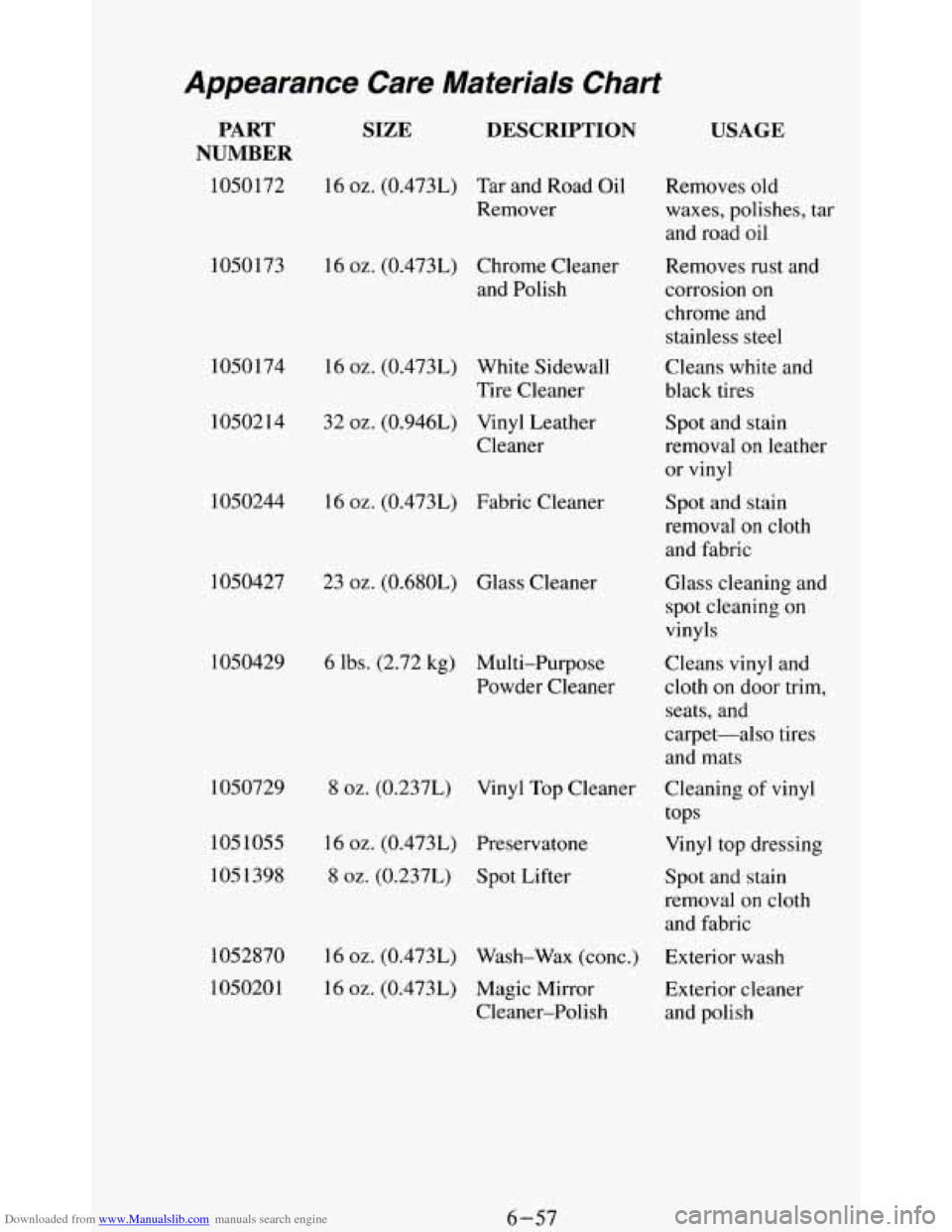1994 CHEVROLET BLAZER tire size
[x] Cancel search: tire sizePage 197 of 348

Downloaded from www.Manualslib.com manuals search engine If you’re using a “dead-weight” hitch, the trailer tongue (A) should weigh
10%
of the total loaded trailer weight (B). If you have a
“weight-distributing” hitch, the trailer tongue (A) should weigh 12% of the
total loaded trailer weight (B).
After you’ve loaded your trailer, weigh the trailer and then the tongue,
separately,
to see if the weights are proper. If they aren’t, you may be able to
get them right simply by moving some items around
in the trailer.
Total Weight on Your Vehicle’s Tires
Be sure your vehicle’s tires are inflated to the limit for cold tires. You’ll find
these numbers
on the Certification label on the driver’s door lock pillar or
see “Tire Loading”
in the Index. Then be sure you don’t go over the GVW
limit for your vehicle.
Hitches
It’s important to have the correct hitch equipment. Crosswinds, large trucks
going by, and rough roads are
a few reasons why you’ll need the right hitch.
Here are some rules
to follow:
If you’ll be pulling a trailer that, when loaded, will weigh more than
2,000 pounds (900 kg), be sure to use a properly mounted,
weight-distributing hitch and sway control of the proper size. This
equipment is very important for proper vehicle loading and good
handling when you’re driving.
0 Will you have to make any holes in the body of your vehicle when you
install a trailer hitch? If you do, then be sure to seal the holes later
when
you remove the hitch. If you don’t seal them, deadly carbon
monoxide (CO) from your exhaust can get
into your vehicle (see
“Carbon Monoxide”
in the Index). Dirt and water can, too.
If your vehicle has a deadweight hitch and a endgate-mounted spare tire,
and your trailer has
a winch or tongue jack, you could have interference
between them.
Safety Chains
You should always attach chains between your vehicle and your trailer.
Cross
the safety chains under the tongue of the trailer so that the tongue will
not drop
to the road if it becomes separated from the hitch. Instructions
about safety chains may be provided by the hitch manufacturer
or by the
trailer manufacturer. Follow
the manufacturer’s recommendation for
attaching safety chains. Always leave just enough slack
so you can turn with
your rig. And, never allow safety chains
to drag on the ground.
4-39
Page 275 of 348

Downloaded from www.Manualslib.com manuals search engine Loading Your Vehicle
The CertificatiodTire label is found on the driver’s door lock pillar. The
label shows
the size of your original tires and the inflation pressures needed
to obtain the gross weight capacity
of your vehicle. This is called the
GVWR (Gross Vehicle Weight Rating). The GVWR includes the weight
of
the vehicle, all occupants, fuel and cargo.
The Certificationnire label
also tells you the maximum weights for the
front and rear axles, called Gross Axle Weight Rating (GAWR). To find
out
the actual loads on your front and rear axles, you need to go to a weigh
station and weigh your vehicle. Your dealer can help you with this. Be sure
to spread out your load equally on both sides
of the centerline.
Never exceed the GVWR for your vehicle, or the Gross Axle Weight Rating
(GAWR) for either the front or rear axle.
And, if you do have a heavy load, you should spread it out.
Using heavier suspension components to get added durability might not
change your weight ratings.
Ask your dealer to help you load your vehicle
the right way.
6-39
Page 281 of 348

Downloaded from www.Manualslib.com manuals search engine When lt’s Time for New Tires
One way to tell when
it’s time for new tires
is to check the
treadwear indicators,
which will appear
when your tires have
only
2/32 inch
(1.6 mm) or less of
tread remaining.
You need a new tire if
0 You can see the indicators at three or more places around the tire.
You can see cord or fabric showing through the tire’s rubber.
The tread or sidewall is cracked, cut or snagged deep enough to show
cord or fabric.
0 The tire has a bump, bulge or split.
The tire has a puncture, cut, or other damage that can’t be repaired well
because
of the size or location of the damage.
Buying New Tires
To find out what kind and size of tires you need, look at the
CertificatiodTire label.
The tires installed
on your vehicle when it was new had a Tire Performance
Criteria Specification (TPC Spec) number
on each tire’s sidewall. When you
get new tires, get
ones with that same TPC Spec number. That way, your
vehicle will continue to have tires that are designed to give proper
endurance, handling, speed rating, traction, ride and other things during
normal service
on your vehicle. If your tires have an all-season tread
design, the
TPC number will be followed by a “MS” (for mud and snow).
6-45
Page 282 of 348

Downloaded from www.Manualslib.com manuals search engine If you ever replace your tires with those not having a TPC Spec number,
make sure they are the same size, load range, speed rating and construction
type (bias, bias-belted or radial) as your original tires.
Uniform Tire Quality Grading
The following information relates to the system developed by the United
States National Highway Traffic Safety Administration which grades tires
by treadwear, traction and temperature performance. (This applies
only to
vehicles sold in the United States.)
Treadwear
The treadwear grade is a comparative rating based on the wear rate of the
tire when tested under controlled conditions on a specified government test
course. For example, a tire graded
150 would wear one and a half (1 1/2)
times as well on the government course as a tire graded 100. The relative
performance of tires depends upon the actual conditions of their use,
however, and may depart significantly from
the norm due to variations in
driving habits, service practices and differences
in road characteristics and
climate.
Traction - A, B, C
The traction grades, from highest to lowest are: A, B, and C. They represent
the tire’s ability to stop on wet pavement as measured under controlled
conditions on specified government test surfaces
of asphalt and concrete. A
tire marked C may have poor traction performance.
Warning: The traction grade assigned to this tire is based
on braking
(straight-ahead) traction tests and does
not include cornering (turning)
traction.
6-46
Page 285 of 348

Downloaded from www.Manualslib.com manuals search engine Tire Chains
NOTICE:
If your vehicle has P235/75R15 size tires, don’t use tire chains;
they can damage your vehicle.
If you have other size tires, use tire chains only where legal and
only when you must. Use only
SAE Class “S” type chains that
are the proper size for your tires. Install them on the drive axle
tires (four-wheel-drive vehicles can use chains on both axles)
and tighten them
as tightly as possible with the ends securely
fastened. Drive slowly and follow the chain manufacturer’s
instructions.
If you can hear the chains contacting your vehicle,
stop and retighten them.
If the contact continues, slow down
until it stops. Driving too fast with chains on will damage your
vehicle.
Appearance Care
1
t
Remember, cleaning products can be hazardous. Some are toxic. Others can
burst into flame if
you strike a match or get them on a hot part of the
vehicle. Some are dangerous if
you breathe their fumes in a closed space.
When you use anything from a container
to clean your vehicle, be sure to
follow the manufacturer’s warnings and instructions. And always open your
doors or windows when you’re cleaning the inside.
6-49
Page 293 of 348

Downloaded from www.Manualslib.com manuals search engine SIZE DESCRIPTION PART
NUMBER
1050172 16 oz. (0.473L) Tar and Road Oil
Remover
1050173 16
oz. (0.4731) Chrome Cleaner
and Polish
1050174 16
oz. (0.473L) White Sidewall
1050214 32
oz. (0.946L) Vinyl Leather
Tire
Cleaner
Cleaner
1050244 16
oz. (0.473L) Fabric Cleaner
1050427 23
oz. (0.680L) Glass Cleaner
1050429
6 lbs. (2.72 kg) Multi-Purpose
Powder Cleaner
1050729
USAGE
Removes old
waxes, polishes, tar
and road oil
Removes rust and
corrosion on
chrome and
stainless steel
Cleans white and
black tires
Spot and
stain
removal on leather
or
vinyl
Spot and stain
removal on cloth
and fabric
Glass cleaning and
spot cleaning on
vinyls
Cleans
vinyl and
cloth
on door trim,
seats, and
carpet-also tires
and mats
8 02. (0.237L) Vinyl Top Cleaner Cleaning of vinyl
tops
105 1055
16 oz. (0.473L) Preservatone
105 1398
8 oz. (0.237L) Spot Lifter
Vinyl top dressing
Spot and stain
removal
on cloth
and fabric
1052870 16
oz. (0.473L) Wash-Wax (conc.)
Exterior wash
1050201
16 oz. (0.473L) Magic Mirror
Exterior cleaner
Cleaner-Polish and polish
6-57